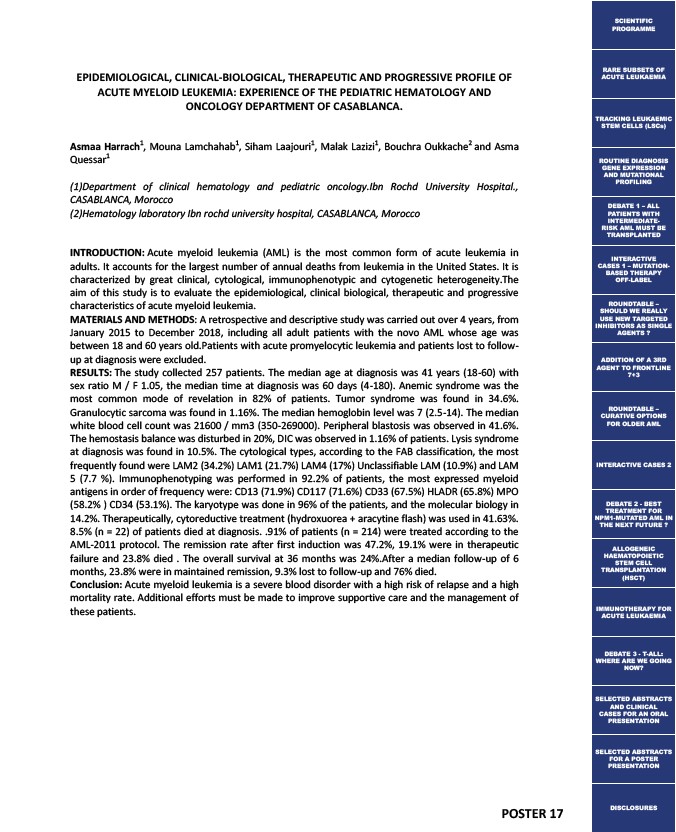
EPIDEMIOLOGICAL, CLINICAL-BIOLOGICAL, THERAPEUTIC AND PROGRESSIVE PROFILE OF
POSTER 17
ACUTE MYELOID LEUKEMIA: EXPERIENCE OF THE PEDIATRIC HEMATOLOGY AND
ONCOLOGY DEPARTMENT OF CASABLANCA.
Asmaa Harrach1, Mouna Lamchahab1, Siham Laajouri1, Malak Lazizi1, Bouchra Oukkache2 and Asma
Quessar1
(1)Department of clinical hematology and pediatric oncology.Ibn Rochd University Hospital.,
CASABLANCA, Morocco
(2)Hematology laboratory Ibn rochd university hospital, CASABLANCA, Morocco
INTRODUCTION: Acute myeloid leukemia (AML) is the most common form of acute leukemia in
adults. It accounts for the largest number of annual deaths from leukemia in the United States. It is
characterized by great clinical, cytological, immunophenotypic and cytogenetic heterogeneity.The
aim of this study is to evaluate the epidemiological, clinical biological, therapeutic and progressive
characteristics of acute myeloid leukemia.
MATERIALS AND METHODS: A retrospective and descriptive study was carried out over 4 years, from
January 2015 to December 2018, including all adult patients with the novo AML whose age was
between 18 and 60 years old.Patients with acute promyelocytic leukemia and patients lost to follow-up
at diagnosis were excluded.
RESULTS: The study collected 257 patients. The median age at diagnosis was 41 years (18-60) with
sex ratio M / F 1.05, the median time at diagnosis was 60 days (4-180). Anemic syndrome was the
most common mode of revelation in 82% of patients. Tumor syndrome was found in 34.6%.
Granulocytic sarcoma was found in 1.16%. The median hemoglobin level was 7 (2.5-14). The median
white blood cell count was 21600 / mm3 (350-269000). Peripheral blastosis was observed in 41.6%.
The hemostasis balance was disturbed in 20%, DIC was observed in 1.16% of patients. Lysis syndrome
at diagnosis was found in 10.5%. The cytological types, according to the FAB classification, the most
frequently found were LAM2 (34.2%) LAM1 (21.7%) LAM4 (17%) Unclassifiable LAM (10.9%) and LAM
5 (7.7 %). Immunophenotyping was performed in 92.2% of patients, the most expressed myeloid
antigens in order of frequency were: CD13 (71.9%) CD117 (71.6%) CD33 (67.5%) HLADR (65.8%) MPO
(58.2% ) CD34 (53.1%). The karyotype was done in 96% of the patients, and the molecular biology in
14.2%. Therapeutically, cytoreductive treatment (hydroxuorea + aracytine flash) was used in 41.63%.
8.5% (n = 22) of patients died at diagnosis. .91% of patients (n = 214) were treated according to the
AML-2011 protocol. The remission rate after first induction was 47.2%, 19.1% were in therapeutic
failure and 23.8% died . The overall survival at 36 months was 24%.After a median follow-up of 6
months, 23.8% were in maintained remission, 9.3% lost to follow-up and 76% died.
Conclusion: Acute myeloid leukemia is a severe blood disorder with a high risk of relapse and a high
mortality rate. Additional efforts must be made to improve supportive care and the management of
these patients.
SCIENTIFIC
PROGRAMME
RARE SUBSETS OF
ACUTE LEUKAEMIA
TRACKING LEUKAEMIC
STEM CELLS (LSCs)
ROUTINE DIAGNOSIS
GENE EXPRESSION
AND MUTATIONAL
PROFILING
DEBATE 1 – ALL
PATIENTS WITH
INTERMEDIATE-RISK
AML MUST BE
TRANSPLANTED
INTERACTIVE
CASES 1 – MUTATION-BASED
THERAPY
OFF-LABEL
ROUNDTABLE –
SHOULD WE REALLY
USE NEW TARGETED
INHIBITORS AS SINGLE
AGENTS ?
ADDITION OF A 3RD
AGENT TO FRONTLINE
7+3
ROUNDTABLE –
CURATIVE OPTIONS
FOR OLDER AML
INTERACTIVE CASES 2
DEBATE 2 - BEST
TREATMENT FOR
NPM1-MUTATED AML IN
THE NEXT FUTURE ?
ALLOGENEIC
HAEMATOPOIETIC
STEM CELL
TRANSPLANTATION
(HSCT)
IMMUNOTHERAPY FOR
ACUTE LEUKAEMIA
DEBATE 3 - T-ALL:
WHERE ARE WE GOING
NOW?
SELECTED ABSTRACTS
AND CLINICAL
CASES FOR AN ORAL
PRESENTATION
SELECTED ABSTRACTS
FOR A POSTER
PRESENTATION
DISCLOSURES